|
 Morganella compacta Morganella compacta
SynonymsLycoperdon compactum
BiostatusPresent in region - Indigenous. Endemic
Images (click to enlarge)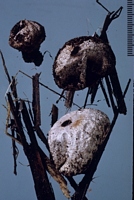
Owner: Herb. PDD | 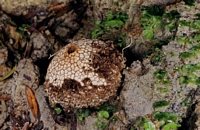
Caption: REB 1340
Owner: Ross Beever | 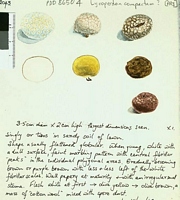
Caption: Watercolour
Owner: G.M. Taylor | 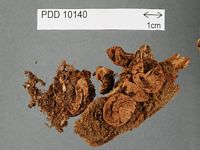
Caption: Dried type specimen
Owner: Herb PDD | 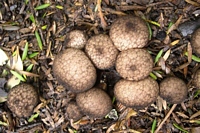
Owner: B. Dee | 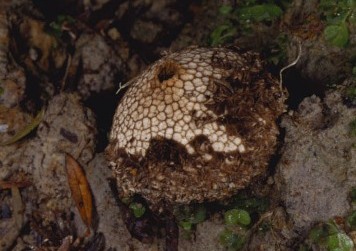
Caption: Morganella compacta
Owner: R.E. Beever | 
Caption: FUNNZ: 2006/0650, See public note for more information
Owner: FUNNZ | 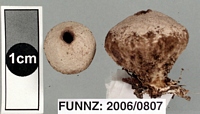
Caption: FUNNZ: 2006/0807, See public note for more information
Owner: FUNNZ | |
Article: Cunningham, G.H. (1926) [1927]. Lycoperdaceae of New Zealand. Transactions and Proceedings of the New Zealand Institute 57: 187-217 Wellington:.
Description: Peridium up to 4 cm. diam., subglobose or pyriform, depressed above, compressed below into a short, stem-like base; exoperidium of strong brown spines, 3-4 mm. long, separate at the base, frequently connivent at the apices, surrounded by a ring of minute brown warts or granules, the spines partially disappearing with age, when the endoperidium appears reticulate from the presence of the persistent rings of granules; endoperidium membranous, ochraceous, becoming brown, dehiscing by an apical, plane, torn, small stoma; sterile base occupying the stem-like base, often rudimentary, minutely cellular, ochraceous ; diaphragm absent. Gleba olivaeeous, pulverulent; columella small, elliptical; capilli¬tium threads hyaline, sparsely branched or simple, septate, diameter of the spores, not pitted. Spares globose, 3.5-4.5 mmm. diam., with caducous pedicels up to 5 mmm. long; epispore olivaceous, closely and finely verrucose.
Habitat: In small groups or caespitose on rotting wood on the forest floor.
Distribution: New Zealand.
Notes: York Bay, Wellington, Feb., 1923, E. H. Atkinson. Type collection.
The species is characterized by the strongly spinous exoperidium, minutely cellular sterile base, hyaline, septate capillitium, and finely verrucose spores. It is peculiar in that it possesses certain characters of several species, for it has the exoperidium of L. echinatum Pens., a sterile base resembling that of L. Hoylei Berk., spores of L. perlatum Pers., and capillitium of L. depnessum Bon. The exoperidium is clothed with long (3-4 mm.) dark brown, almost black spines, which are free at their bases, but frequently connivent at their apices; at the base each is surrounded with a ring of numerous coloured granules. When the spines fall away, the endoperidium appears reticulate, owing to the presence of these rings of granules, which persist and form a net-like series of fine lines. The habit of growing upon wood is also a feature of the plant, being peculiar to only one other New Zealand species, L. piriforme.
|